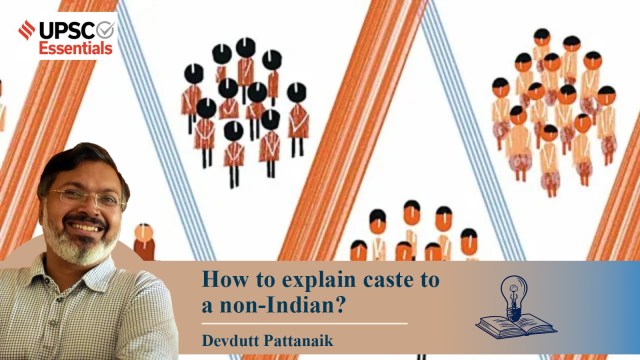© IE Online Media Services Pvt Ltd
Latest Comment
Post Comment
Read Comments
 Caste and tribe are primal identities, tough to wipe out because while caste enables discrimination, it also enables identity and pride in communities. (File Photo)
Caste and tribe are primal identities, tough to wipe out because while caste enables discrimination, it also enables identity and pride in communities. (File Photo)(The Indian Express has launched a new series of articles for UPSC aspirants written by seasoned writers and scholars on issues and concepts spanning History, Polity, International Relations, Art, Culture and Heritage, Environment, Geography, Science and Technology, and so on. Read and reflect with subject experts and boost your chance of cracking the much-coveted UPSC CSE. In the following article, Devdutt Pattanaik, a renowned writer who specialises in mythology and culture, provides a nuanced understanding of castes in India.)
The easiest way to understand caste is to turn our gaze upon Africa. An African has a tribal identity (Masai, Zulu), a religious identity (Christian, Muslim), a national identity (Rwanda, Uganda) and even a racial identity (Mediterranean, Sub-Saharan, European). Of these, the tribal identity is organic and indigenous. Intellectuals often blame tribalism for ethnic strife and lack of progress in African nations. At one level, caste in India is very much like a tribe in Africa. Like a tribe, every caste has its own unique customs and beliefs, that it may or may not share with other castes.
However, caste is also very different from tribe. Castes exist in a superstructure, which has many regional variations. It was relatively dynamic before being fixed by the British colonial administration. It is important to remember that the word ‘caste’ is a European invention; the traditional Indian word is jati. There are over 2,000 jatis in India and these are categorised into four varnas of the Rig Veda. But the reality is far more dynamic and complex.
The caste structure has within it economic and political hierarchies, and so can be confused with class systems. But what makes caste unique is the doctrine of purity. For at least 1,500 years, if not longer, what has remained consistent is the existence of the two extreme ends of the superstructure – the pure and impure castes.
The Brahmin forms the highest cluster and continues to dominate India’s politics, bureaucracy, judiciary and even the corporate world. At the other end of the spectrum are communities deemed impure, mostly involved in vocations such as cremation, meat processing, leatherwork and sanitation.
They were deemed ‘untouchable’ and thus dehumanised, denied access to common facilities like the village well and the village square. Their sight, their shadow and their touch was shunned. They lived invisible lives on the periphery of the village, coming in to do their caste-based jobs only when others were indoors.
Hindu social reformers mostly came from elite groups. They did not challenge the caste superstructure head on in the spirit of pragmatism. For example, Mahatma Gandhi, trained as a lawyer in London, used the term Harijan (God’s people) to uplift these communities. This term was abandoned over time, as it was considered to be rather patronising.
The term chosen by the community itself for self-identification is Dalit (downtrodden), a reminder of centuries of oppression. In recent times, many have drawn a parallel to the plight of the Dalit in Indian villages and the African slaves in American colonies. So many people see casteism through the lens of racism, demanding structural changes.
It took a lawyer named BR Ambedkar, himself a Dalit, to introduce the radical idea of ‘annihilation of caste’ to achieve true equality. Ambedkar headed the committee that drafted India’s Constitution and shaped many policies that have guided the Republic of India since independence. The Indian Government today refers to Dalit communities as Scheduled Castes (SCs) and Scheduled Tribes (STs), and grants them positive discrimination through the reservation of educational and job opportunities.
But is caste an essential component of Hinduism itself? Yes, say the Dalits. No, say the privileged elite. Is there Hinduism outside of caste? No, say the Dalits. Yes, say the privileged elite. If one accepts the Dalit line, then anti-caste movements become essentially anti-Hindu movements. All religious missionaries support anti-caste movements.
While these religions argue that their faith is egalitarian, the ground reality in India is that caste is never eradicated despite conversion. In Goa, for example, you can find proud Brahmin Catholics who will never marry Dalit Christians. In Pakistan, pride is taken in the Muslim Rajput identity and Dalits who convert to Christianity are subject to caste violence that is masked as religious violence. In North-east India what seems to be Hindu-Christian clashes turns out to be nothing but old tribal rivalries.
Caste and tribe are primal identities, tough to wipe out because while caste enables discrimination, it also enables identity and pride in communities. Every caste celebrates its heroes and history in the name of cultural pride. This is at the root of vote bank politics.
Caste and tribe are considered primal identities that are difficult to eradicate. Comment.
How is the concept of caste in India similar to the idea of tribes in Africa in terms of customs and beliefs?
How does caste superstructure shape Indian society, and how does it vary regionally? Discuss with examples.
In what ways does BR Ambedkar’s idea of “annihilation of caste” influence current debates about caste-based affirmative action and social justice in India?
How do the perspectives of Dalits and the privileged elite differ on the relationship between caste and Hinduism?
(Devdutt Pattanaik is a renowned mythologist who writes on art, culture and heritage.)
Share your thoughts and ideas on UPSC Special articles with ashiya.parveen@indianexpress.com.
Subscribe to our UPSC newsletter and stay updated with the news cues from the past week.
Stay updated with the latest UPSC articles by joining our Telegram channel – IndianExpress UPSC Hub, and follow us on Instagram and X.

Read UPSC Magazine